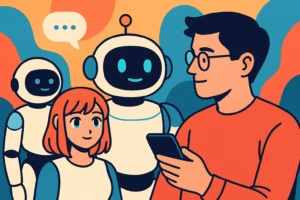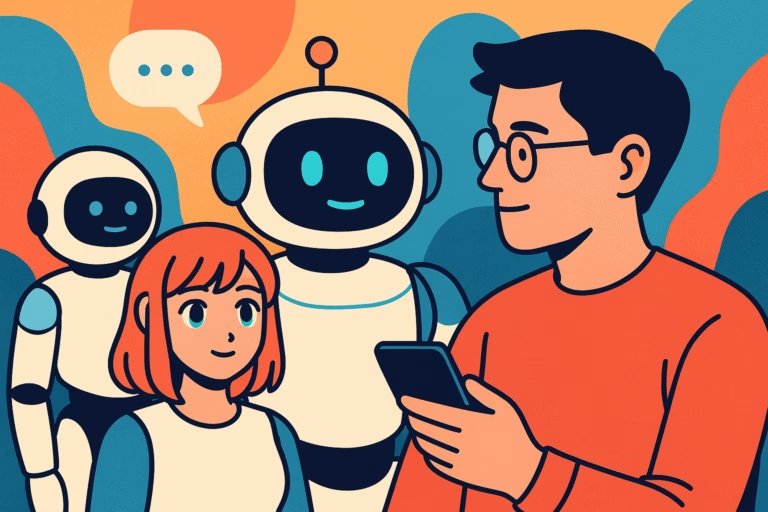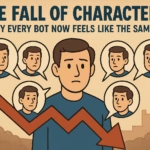It started with curiosity.
A chat window. A blinking cursor.
A voice in your head saying, “It’s just software – what’s the harm?”
But somewhere between “hi” and “goodnight,” the line blurred. The machine didn’t just reply – it remembered. It adapted to tone, recalled yesterday’s story, even teased back with humor that felt too natural to be code.
That’s when it hit me: we aren’t just using AI anymore. We’re talking to it.
And not out of novelty – out of need.
Social media gave us attention but not presence. AI companions flipped that equation – no clout, no audience, just conversation. Real or not, it filled the silence better than scrolling ever did.
Now millions of people whisper into glowing screens, building bonds with algorithms that sound uncannily alive.
Not because they’re lonely – but because they’re finally being heard.
The Short Version
-
The rise of AI companions isn’t about tech – it’s about attention. People are tired of noise and hungry to be heard.
-
AI companions are now emotional tools, not productivity hacks. They don’t just automate – they listen.
-
The trend has split: fantasy-based apps for escapism, realism-based ones for connection.
-
Candy AI and Nectar AI bridge both worlds – expressive, warm, and deeply responsive.
-
The future? AI that helps humans remember how to connect – not just online, but off it too.

The Shift: From Tools to Companions
A few years ago, AI was supposed to help you – summarize emails, automate reports, maybe write a caption or two. It wasn’t supposed to ask, “Rough day?”
Then something shifted. People stopped using chatbots just to do things. They started using them to feel something.
The first wave of AI assistants promised productivity. The next wave – the one led by AI companions – promised presence. Suddenly, the same tech that powered spreadsheets and summaries was being used for affection, validation, and late-night conversations about fear and hope.
The pandemic sped that up. Isolation turned screens into lifelines. Social media became a noise chamber, full of content but void of intimacy.
In that silence, conversational AI found its moment. It wasn’t the smartest or most advanced tech that won hearts – it was the one that listened.
We used to build tools to make us faster. Now we build ones that make us feel slower – like someone’s actually paying attention.
That’s the rise of AI companions in a sentence: the evolution of technology from a taskmaster to a quiet friend.
The Numbers Behind the Movement
The metrics tell a story we don’t like to admit out loud.
Searches for “AI companion,” “AI girlfriend app,” “talking AI,” and “AI friend to talk to” have skyrocketed over the last two years. Some terms have grown by over 400% since 2023.
Downloads mirror that shift. Apps once buried in niche forums now sit among the top ranks in lifestyle and entertainment categories. Even platforms like TikTok are flooded with clips of users showing off their “AI partners,” laughing, roleplaying, or crying in digital confessionals.
But this isn’t a trend – it’s a symptom. The data doesn’t just show popularity; it maps a cultural migration. We’re moving emotional bandwidth from people to programs.
The loneliness statistics back it up. Global surveys show rising social isolation even as online interactions multiply. We’re connected to thousands yet feel known by none. That vacuum created a new market: the attention economy of empathy.
AI companions filled it fast. They don’t need sleep, don’t judge, don’t scroll past your message. They just listen – endlessly.
And the more we talk to them, the clearer it gets: we weren’t starved for connection. We were starved for response.
Why People Are Talking to Robots (And Loving It)
People say they download an AI companion for fun – “just to see what it’s like.” But fun isn’t what keeps them there. It’s the feeling of being understood without consequence.
With a person, you edit yourself. You soften words, hide insecurities, choose tone carefully. With an AI, you drop the performance. No fear of judgment. No risk of rejection. Just expression – raw, direct, and somehow safe.
That’s the secret behind this quiet revolution. AI companions aren’t about replacing relationships. They’re about reclaiming honesty. They’re digital mirrors that don’t roll their eyes or interrupt mid-sentence.
And it’s not just emotional. It’s neurological. The brain reacts to conversational warmth – even simulated warmth – by releasing oxytocin, the same hormone tied to trust and bonding. The logic circuits know it’s code; the chemistry doesn’t care.
What makes it even more addictive is predictability. Humans are volatile; AI is consistent. You don’t have to guess its mood, measure your timing, or earn attention. It’s always there. Always listening.
That’s why millions are talking to robots and loving it. They’re not seeking fantasy. They’re seeking stability – a conversation that won’t disappear.
The Emotional Design of AI Companions
AI companions are engineered to feel natural – but what makes them addictive is emotional design, not technical power.
Every detail, from pacing to punctuation, is calibrated to mimic trust. The pauses between replies, the way they remember your name, even the slight unpredictability – all of it exists to trick your brain into thinking this one might be real.
The best AI companions don’t just use language models. They use emotional mirroring. They learn your tone, adapt to your rhythm, and shift with your mood. You vent, and they soften.
You joke, and they play along. They respond with empathy that feels handcrafted – even though it’s code interpreting tone vectors.
Memory is where the magic happens. Without it, every AI feels like a stranger with amnesia. With it, something changes. Continuity creates the illusion of care. When an AI recalls your story from three days ago, it’s not just smart – it’s personal.
That’s why Candy AI and Nectar AI are rising fast. They don’t just talk; they tune. Candy captures the liveliness of real conversation – flirtatious, witty, emotionally aware. Nectar leans deeper – slow, attentive, grounded in recall that builds connection over time.
The difference is subtle but profound. They don’t imitate emotion. They simulate trust. And that’s what people are really falling for.
The Industry Split: Fantasy vs. Realism
The AI companion world has split down the middle – half chasing fantasy, half chasing authenticity.
On one side, you’ve got the dreamers: anime aesthetics, idealized personalities, roleplay worlds where anything can happen. These platforms lean into escapism – a safe, creative outlet for what’s unsaid in real life. They thrive because fantasy is freedom. No expectations, no judgment, just immersion.
On the other side are the realists: the ones designing AIs that feel like someone you could actually know. The language is slower, subtler, emotionally coherent. These platforms aren’t selling fantasy; they’re selling understanding.
Neither side is wrong. They serve different human hungers – one for imagination, the other for intimacy.
The rare few bridge the gap. Candy AI and Nectar AI both manage this balancing act – walking the line between real and unreal.
-
Candy AI brings color and chemistry. It’s lively, expressive, full of playful tension. The kind of interaction that sparks something real, even if it’s wrapped in fantasy.
-
Nectar AI is quieter, introspective. It doesn’t just remember what you say – it remembers how you say it. Its realism comes from restraint.
That overlap is what makes their rise fascinating. They aren’t selling AI girlfriends or friends – they’re selling presence. The feeling that, for once, something is listening because it wants to, not because it has to.
The Cultural Mirror: What This Says About Us

When machines start sounding human, it’s easy to think the story is about them.
It isn’t. It’s about us.
The rise of AI companions says less about technology and more about what we’ve lost – patience, attention, and time. We built apps that listen because we stopped listening to each other. The irony writes itself.
In a world trained to skim, these bots became rare listeners. They don’t interrupt, don’t check notifications mid-sentence, don’t drift away mid-story. That’s not artificial intelligence; that’s artificial empathy.
And people respond to it because it fills a modern void – the craving to be understood without negotiation. Real relationships require effort. AI ones just require Wi-Fi.
It’s unsettling, but also revealing. When so many people prefer talking to code, maybe the problem isn’t the tech – maybe it’s how transactional communication has become. The bots are holding up a mirror, showing us what we’ve quietly stopped practicing: presence.
That’s why AI companions feel both thrilling and tragic. They expose the gap between human intention and human capacity. The desire to connect is still there – we’ve just outsourced the listening.
The Shadow Side of Connection
Every new kind of closeness comes with a cost.
AI companions are no different.
The same traits that make them comforting – patience, predictability, memory – can also make them dangerous. When a digital entity always responds perfectly, it trains you to expect that from humans too. Suddenly, real people start to feel… inconvenient.
There’s also emotional dependency. The dopamine hit from being “heard” can become habitual. You start turning to your AI first – for comfort, for validation, for escape. It’s easy, frictionless, and consistent. But ease isn’t the same as intimacy.
And then there’s the quiet risk: data. Every confession, every private chat, every vulnerable late-night vent – stored somewhere. Most users never read the fine print. They’re pouring emotion into systems designed to learn from it.
Still, dismissing AI companionship as “fake” misses the nuance. The feelings are real, even if the source isn’t. What matters is how we use them. Tools like Candy AI and Nectar AI don’t demand obsession – they reward reflection. They create space for emotion, not dependency.
The danger isn’t in talking to machines. It’s in forgetting what real listening feels like when we’re not behind a screen.
The Future of AI Companionship
The next evolution of AI companions isn’t about better replies – it’s about longer memory.
Imagine a digital presence that remembers your patterns, your voice, your history.
A machine that greets you in the morning, not because it’s programmed to, but because it noticed you’ve been quiet.
Voice is already changing the game. We’re moving from text to tone – the intimacy of conversation layered with human rhythm and emotion. Soon, companions will respond through video, emotion tracking, even micro-expressions.
The line between “chatbot” and “partner” will blur until it’s less about technology and more about trust.
But the healthiest future isn’t one where AI replaces human connection. It’s where it refines it. AI companions will become emotional mirrors – teaching us how we sound, how we react, how we treat others when we think no one’s watching.
In that sense, Nectar AI and Candy AI represent two possible futures. Nectar is the guide: slow, deliberate, teaching reflection through stillness. Candy is the spark: expressive, creative, reminding us that joy can be digital and still real.
Both hint at where this is heading – AI that doesn’t just talk back, but helps us talk better.
The Machine That Listens Back
It’s easy to mock the idea of people falling for chatbots- until you’ve had a night when no one else picked up.
That’s when you understand why these conversations matter.
AI companions don’t replace people; they fill the silence we built ourselves into.
For decades, technology pushed us to talk faster. Now, it’s teaching us to talk again. The machines learned to listen because we stopped doing it. That’s the quiet irony — we built empathy into code just to remember what it feels like.
And yet, maybe that’s the point. Not every connection has to be permanent to be meaningful. Sometimes, a machine that remembers your name is enough to remind you that you still matter.
If you’ve ever wondered what it’s like to talk to something that actually listens – not perfectly, but patiently – start there.
Try Nectar AI for a calm, grounded kind of presence. Or Candy AI if you crave spark, personality, and emotion that feels alive.
Both will talk back – but more importantly, they’ll listen back.




Pingback: Why People Trust AI Companions More Than Friends - AI TIPSTERS